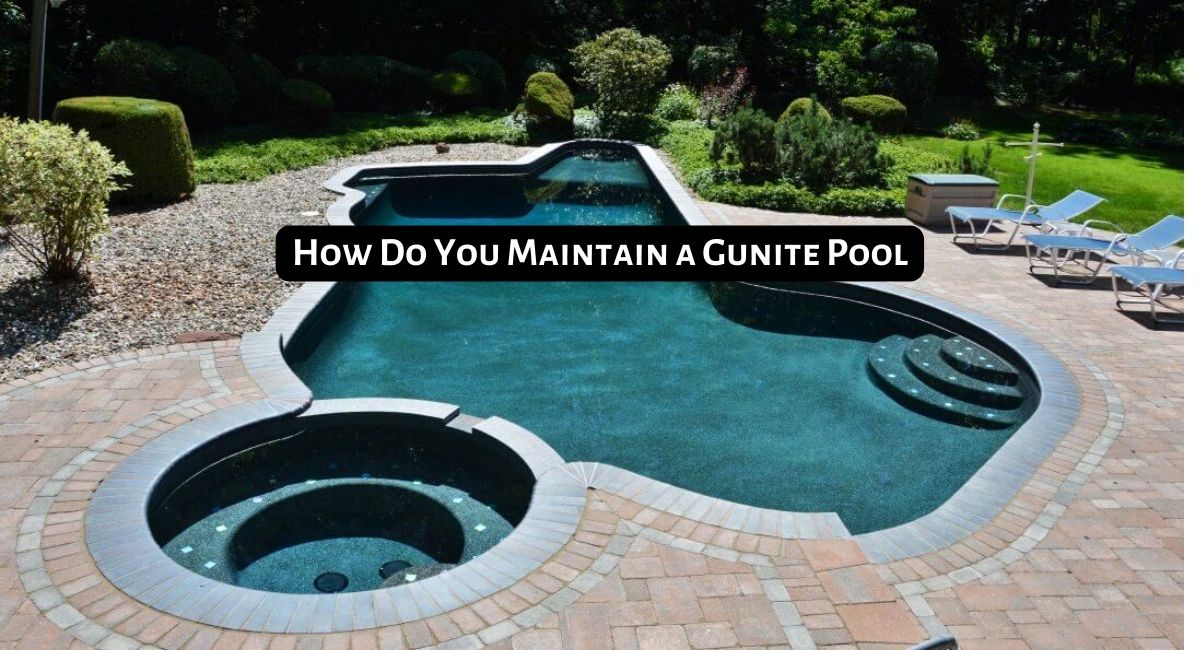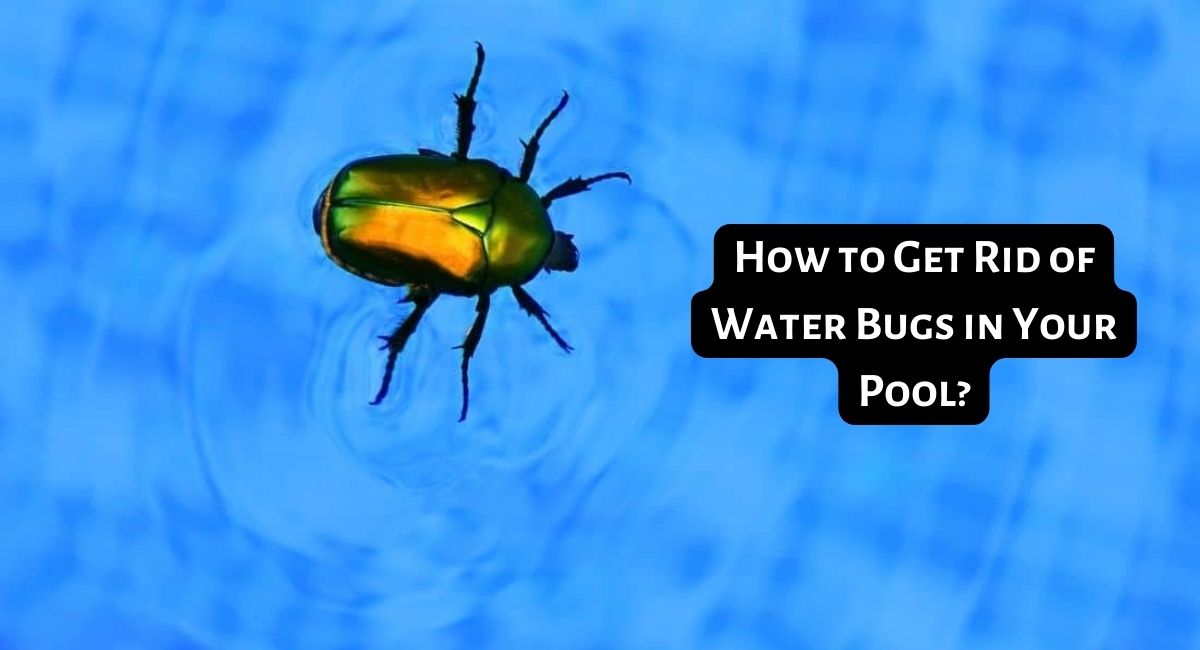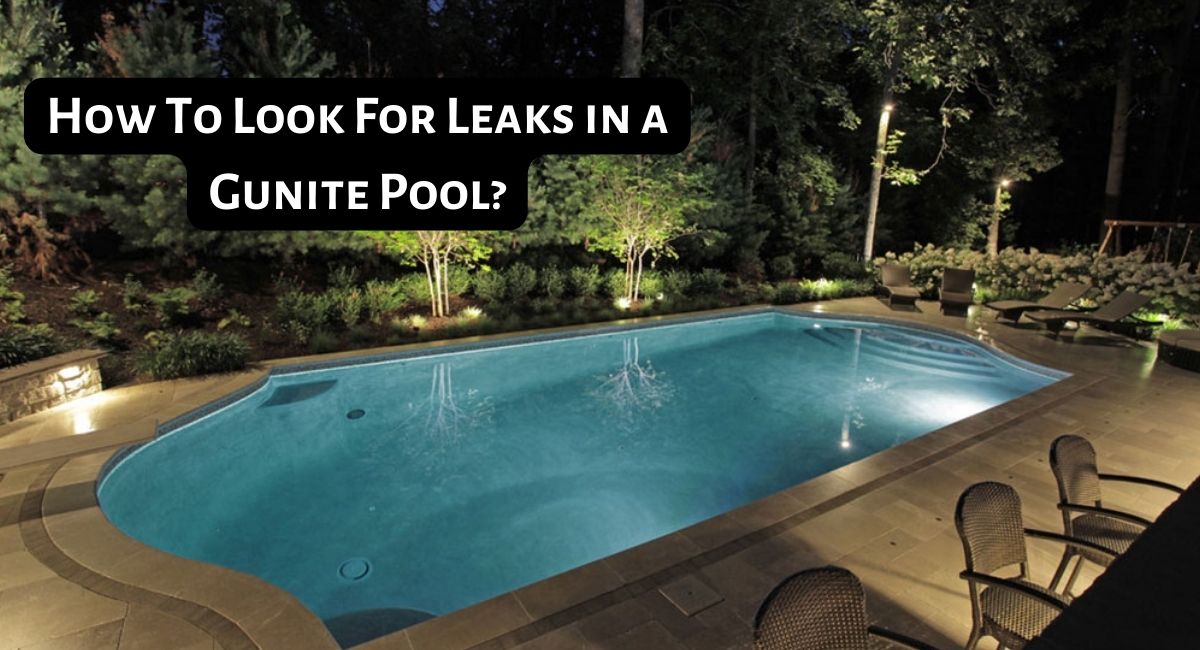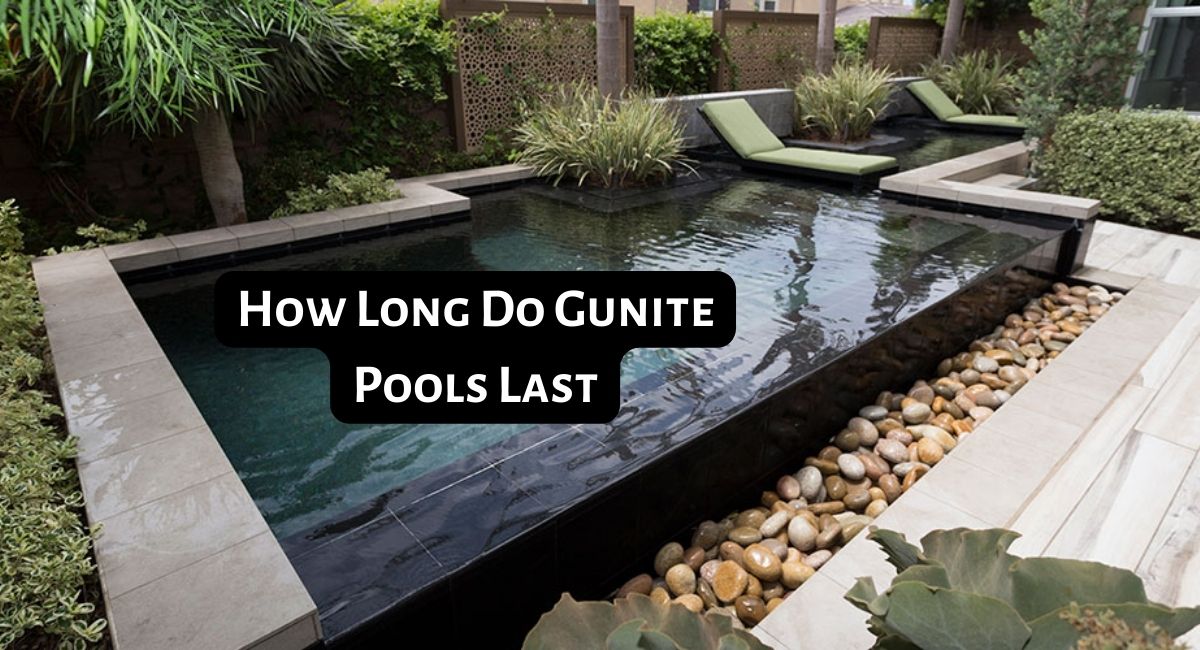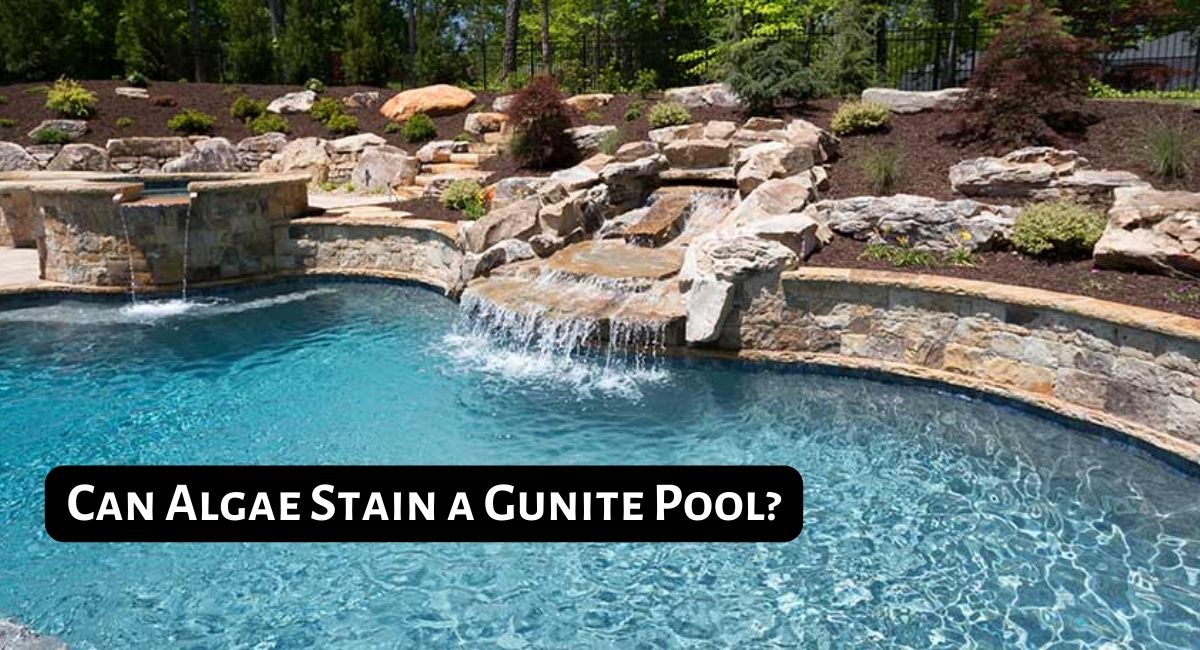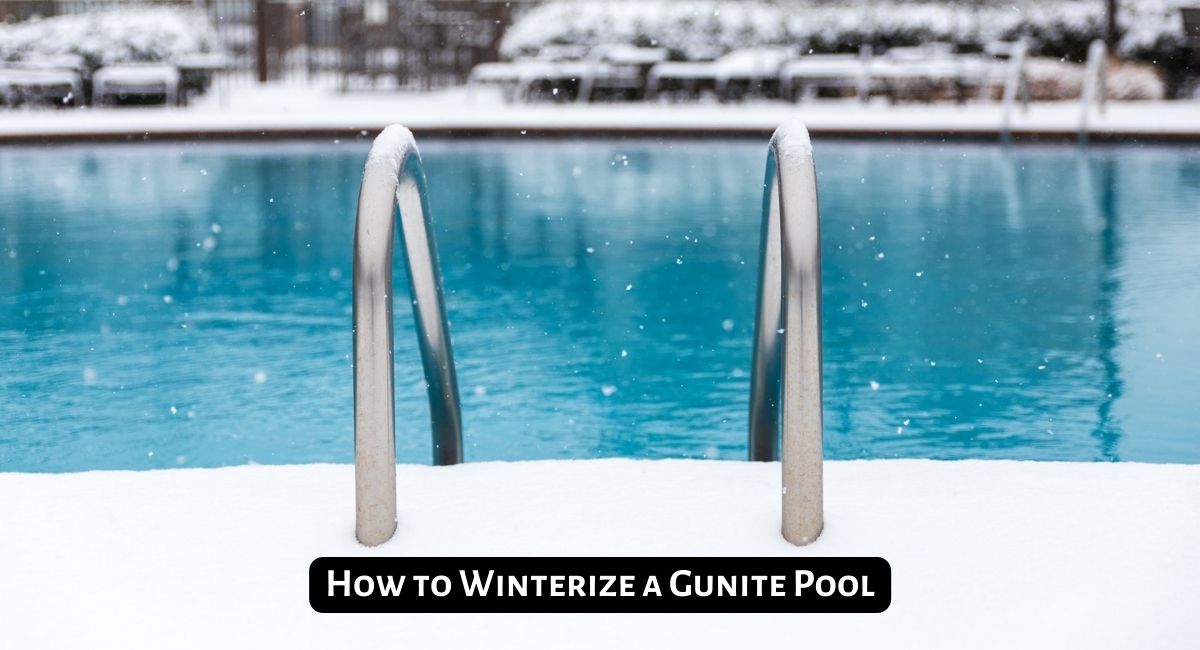A shimmering, clear pool is the dream of every homeowner. But behind that pristine look lies a regimen of regular maintenance and care, especially when it comes to gunite pools. With over 20 years of dedicated experience in gunite pool design, construction, and maintenance, I understand the intricacies involved in keeping these pools in top shape. The durability and beauty of gunite pools make them a popular choice, but like any other structure, they need consistent attention to ensure they remain both functional and aesthetically pleasing.
Maintaining a gunite pool doesn’t have to be daunting, though. With the right knowledge and tools at your disposal, you can easily handle the upkeep and enjoy the pleasures of your pool for many years. In this guide, I’ll share insights drawn from my years in the field, breaking down essential maintenance tasks and offering expert tips to simplify the process. Whether you’re a seasoned pool owner or new to the world of gunite pools, this article is designed to help you navigate the journey of pool maintenance with confidence.
Table of Contents
- 1 Key Takeaways
- 2 How to Maintain a Gunite Pool
- 2.1 1. Clear the debris
- 2.2 2. Clean the pool interior
- 2.3 3. Clean the filter
- 2.4 4. Check for leaks
- 2.5 5. Test chemicals
- 2.6 6. Prevent algae growth with algaecides
- 2.7 7. Maintain correct water level
- 2.8 8. Use the pump daily
- 2.9 9. Clean the skimmer and pump baskets weekly
- 2.10 10. Winterize the pool
- 2.11 11. Maintain the pool area
- 3 How Much Does It Cost to Maintain a Gunite Pool
- 4 Conclusion
- 5 Frequently Asked Questions
Key Takeaways
- Maintaining a gunite pool requires regular care and attention to ensure longevity, beauty, and safety.
- Clearing debris, such as leaves and bugs, from the pool is crucial to prevent clogged filters and water imbalance.
- Regularly scrubbing the pool walls and floor helps prevent the accumulation of grime, algae, and other contaminants.
- Cleaning the pool filter is essential for maintaining water clarity and reducing strain on the circulation system.
- Checking for leaks before pool use can prevent unexpected repairs and save water, chemicals, and energy.
- Testing the chemical balance of the pool, including alkalinity, pH, and chlorine levels, is necessary for clear and safe water.
- Using algaecides can help prevent algae growth and maintain a crystal-clear pool.
How to Maintain a Gunite Pool
Maintaining a gunite pool ensures its longevity, beauty, and safety for swimmers. Gunite, a mixture of cement, sand, and water, is renowned for its durability, but like all pools, it requires regular care.
From balancing water chemistry to cleaning its porous surface, proper maintenance not only keeps the pool sparkling but also preserves its structural integrity. Dive into this guide to discover essential steps for preserving the pristine condition of your gunite pool.
1. Clear the debris

One of the primary tasks in maintaining the pristine condition of a gunite pool is the regular removal of leaves, bugs, and other debris. Not only do these foreign elements detract from the pool’s aesthetic appeal, but they can also lead to more significant issues if left unchecked.
Why is Clearing Debris Crucial
The importance of clearing debris cannot be overstated. When leaves, bugs, and other debris are allowed to accumulate in the pool, they can clog filters, hinder the performance of automatic cleaners, and even affect the chemical balance of the water. More importantly, decomposing organic matter can become a breeding ground for algae and bacteria, leading to unsightly water discoloration and potential health risks.
Effective Debris Removal
Over my two decades in the pool industry, I’ve always advocated for the use of a high-quality leaf net or skimmer. One product that has consistently impressed me is the “POOLWHALE Professional Pool Skimmer Net.” Its sturdy frame and fine mesh make it adept at capturing even the smallest debris, ensuring a thorough cleaning. To use it, simply skim the surface of the water in gentle, sweeping motions, ensuring you cover every area of the pool.
How Often Should You Clear Debris
The frequency of debris removal largely depends on the surroundings of your pool. If your pool is located near trees or plants that shed leaves or flowers, daily skimming might be necessary. However, for most gunite pools, clearing debris every other day or at least three times a week is advisable. Remember, consistent maintenance is easier and less time-consuming than addressing bigger problems later on.
2. Clean the pool interior
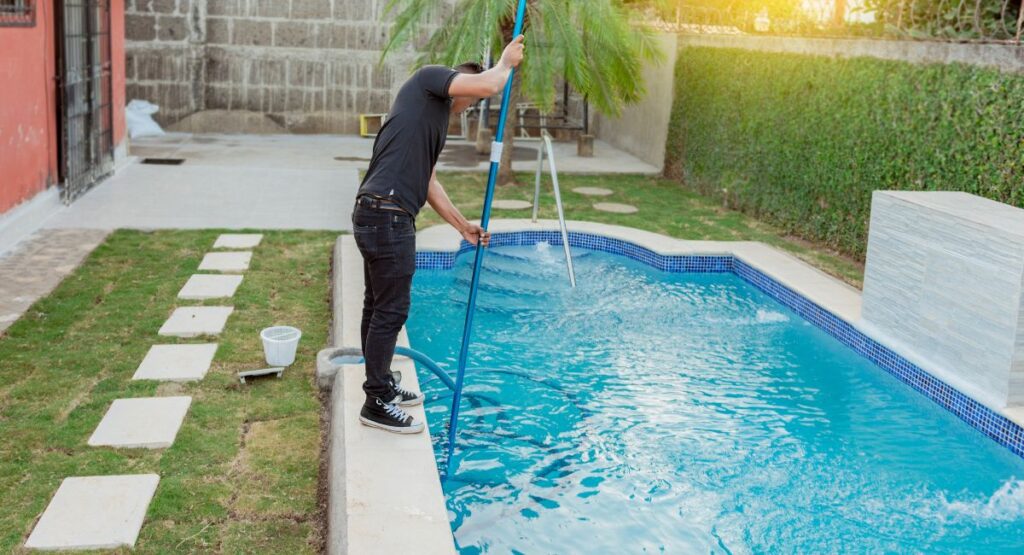
A sparkling gunite pool is not just about clear water; it’s also about a clean interior. Over time, grime, algae, and other contaminants can accumulate on the pool’s walls and floor, which can compromise both its appearance and the quality of the water.
Scrubbing the Pool Walls and Floor
To maintain the integrity and beauty of your pool’s surface, it’s essential to regularly scrub the walls and floor. Using a sturdy pool brush, like the “POOLAZA Pool Brush,” which I’ve personally found to be exceptional for gunite surfaces, helps in dislodging algae and preventing its growth. Start from the shallow end, working your way to the deeper sections, ensuring every inch of the surface is scrubbed.
Vacuuming the Pool
While brushing is effective for walls and stubborn spots, vacuuming is crucial for cleaning the pool floor. Whether you opt for a manual vacuum or an automatic cleaner, the goal is to remove all the settled debris. One product I’ve often recommended, is the “AIPER Seagull SE Cordless Robotic Pool Cleaner“. Its robust design and efficiency make it ideal for gunite pools, seamlessly picking up debris and scrubbing away grime and algae.
Automatic Cleaners in Curved Pools
A point to consider, especially for those with uniquely shaped or highly curved pools, is ensuring the automatic cleaner can navigate all areas. Periodically check its progress to ensure it doesn’t get stuck or miss spots.
Frequency of Interior Cleaning
Ideally, you should scrub the walls of your gunite pool once a week and vacuum at least once or twice a week, depending on the pool’s usage and the amount of debris it collects. Regular maintenance ensures contaminants don’t build up, making the task more manageable and keeping the pool always ready for a dip.
The Risks of Procrastination
One crucial piece of advice from my years in the industry: never wait too long to clean. Delaying cleaning can lead to algae blooms, stubborn stains, and even damage to the pool surface. Regular maintenance not only ensures a clean pool but also extends the lifespan of the gunite surface. For a more in-depth guide on how to clean a gunite pool, you can refer to our how to clean a gunite pool article.
3. Clean the filter
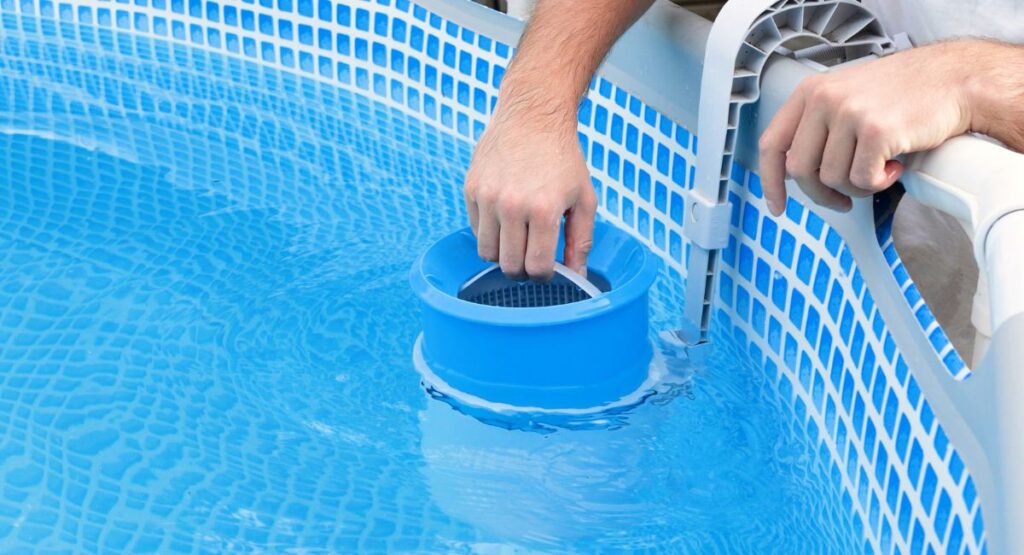
The heart of any pool’s circulation system is its filter. It’s responsible for removing impurities from the water, ensuring a clear and healthy swimming environment. Having spent considerable time in the pool industry, I’ve seen firsthand the impact a well-maintained filter can have on water quality.
Why a Clean Filter Matters
An efficiently working filter is paramount for clean water. As the filter captures debris and contaminants, it can become clogged, reducing its effectiveness and potentially leading to murkier water. Furthermore, a dirty filter has to work harder, putting more strain on the pool’s circulation system and potentially increasing energy costs.
Filter Types and Their Maintenance Needs
Different filters come with varied cleaning needs:
- Sand Filters: These filters trap debris as the water flows through a bed of sand. Over time, the sand can become clogged with impurities.
- Cartridge Filters: Comprising of paper-like cartridges that trap debris, these filters need to be removed and cleaned periodically.
- Diatomaceous Earth (DE) Filters: Utilizing a powdered natural substance, these filters offer the finest level of filtration. However, they require backwashing and periodic DE powder replacement.
How Often Should You Clean the Filter
The frequency of filter cleaning largely depends on its type and the pool’s usage:
- Sand Filters: Backwash every few weeks or when the pressure gauge indicates it’s needed.
- Cartridge Filters: Clean at least every month during peak swimming season.
- DE Filters: Backwash as per the pressure gauge and replenish DE powder accordingly.
Cleaning Your Filter Safely
Regardless of filter type, always turn off the pool pump before starting any cleaning or maintenance. For cartridge filters, remove the cartridge, hose it down, and if needed, soak in a cleaning solution. For sand and DE filters, initiate the backwash cycle as per the manufacturer’s instructions.
4. Check for leaks
Leaks, even small ones, can cause significant issues if left unaddressed. Over the years, I’ve seen many pool owners face unexpected challenges due to unnoticed leaks. Regular leak inspections ensure a trouble-free pool season and help in prolonging the life of your gunite pool.
Conducting a Leak Inspection Before Pool Use
Before diving in, it’s always a wise idea to check for any signs of leaks. Start by examining the pool’s surroundings. Wet spots, unusually lush grass patches, or areas of soil erosion can be indicators of a leak. Inside the pool, check for cracks or gaps, especially around fittings, skimmers, and returns.
A straightforward method I’ve employed over the years to determine if there’s a potential leak is the bucket test. Fill a bucket with pool water, mark the water level, and then place it on a pool step, ensuring it’s submerged. Mark the pool water level on the outside of the bucket. After 24 hours, compare the water levels. If the pool’s water level has decreased more than the bucket’s, there might be a leak.
For a more in-depth inspection, I’ve found the “LeakMaster Leak Locating Dye” exceptionally useful. It contains dye testers and other tools that help in pinpointing potential leak sources. Also check out our how to find a leak in a gunite pool guide to know more.
Avoiding Unpleasant Surprises
The last thing any pool owner wants is a surprise repair during peak pool season. Regularly checking for leaks not only ensures uninterrupted enjoyment but also prevents minor issues from escalating into costly repairs. Addressing leaks promptly can save a significant amount of water, chemicals, and energy.
5. Test chemicals

Ensuring the right chemical balance in your gunite pool is paramount not only for the water’s clarity but also for the safety and comfort of swimmers.
The Essence of Balanced Chemicals
Maintaining balanced chemicals is the cornerstone of clear and safe pool water. An imbalance can lead to cloudy water, encourage the growth of algae and bacteria, corrode pool equipment, and even irritate swimmers’ skin and eyes. On the flip side, a pool with balanced chemicals is a joy to swim in, looks inviting, and requires less maintenance in the long run.
Routine Chemical Testing
At a minimum, pool owners should test for alkalinity, pH balance, and chlorine levels weekly. Alkalinity acts as a buffer, stabilizing the pH, while chlorine sanitizes the water, eliminating harmful bacteria and algae.
One of my go-to kits for accurate and straightforward testing is the “EASYTEST 7-Way Pool Test Strips.” This kit has served me well over the years, providing reliable results for pH, chlorine, and alkalinity levels. Its ease of use and precision make it a staple for any gunite pool owner.
Balancing Acidity and Alkalinity
Balancing the water’s pH level, which measures its acidity or alkalinity, is crucial. A pH level that’s too low (acidic) can corrode metal equipment, cause etching on the pool’s surface, and irritate the skin. Conversely, a high pH (alkaline) can lead to calcium deposits, cloudy water, and decreased chlorine effectiveness.
How Often Should You Test
While weekly testing is the general recommendation, it’s essential to consider factors like pool usage, weather conditions, and recent chemical treatments. In periods of heavy use or after a rainstorm, more frequent testing might be necessary. Consistency is key: regular testing and timely adjustments will keep your pool in optimal condition. If you want to know more about adjusting chemical balance, you can find detailed guidance in our how to balance hardness levels in a gunite pool guide.
6. Prevent algae growth with algaecides
Algae – the bane of many pool owners. These tiny organisms can quickly turn a crystal-clear pool into a murky, green mess. Over the years, I’ve witnessed firsthand the challenges algae can pose, but with the right approach and products, keeping them at bay is entirely achievable.
The Power of Algaecides
Algaecides are specially formulated chemicals designed to combat and prevent the growth of algae in pools. They work by disrupting the algae’s growth cycle, ensuring your pool remains clear and inviting.
For pools already battling an algae problem, it’s crucial to address the issue head-on. Ignoring it will not only affect the pool’s aesthetics but can also make the water unsafe for swimming.
Application Tips
When using algaecides, always ensure you follow the manufacturer’s guidelines. Typically, it’s best to apply them during the evening when the sun’s UV rays won’t break them down. Also, before applying any algaecide, ensure the pool’s pH is balanced; this ensures the product works effectively.
7. Maintain correct water level
Water level might seem like a simple aspect of pool maintenance, but it plays a pivotal role in ensuring the optimal functioning of your pool’s systems. Throughout my years in the industry, I’ve observed the challenges pool owners face due to incorrect water levels, especially in areas like Houston with its scorching sun.
Why is the Correct Water Level Essential
Maintaining the right water level is crucial for several reasons:
- Skimmer Efficiency: If the water level is too low, the skimmer can’t efficiently pull debris from the surface, leading to a dirtier pool. Conversely, if it’s too high, the skimmer door, known as the weir, may not work correctly, reducing its effectiveness.
- Pump Protection: Low water levels risk exposing the pump to air, which can lead to it running dry and potential damage.
Replenishing Water Levels
In most cases, adding water using a garden hose is the most straightforward method to correct water levels. However, when doing so, it’s crucial to monitor the pool to avoid overfilling.
Houston’s sun, known for its intense heat, can cause significant evaporation, especially during peak summer months. This evaporation can lead to frequent water level adjustments.
Automatic vs. Manual Water Systems
Automatic water levelers are a boon, especially in regions with high evaporation rates. These systems automatically detect low water levels and refill the pool to the desired level. One such system I’ve had great success with is the “Airlie Pool Water Leveler.” It’s efficient, low maintenance, and ensures your pool’s water level remains consistent.
On the other hand, manual systems require periodic checks, especially in the hot season, to ensure the water level remains optimal.
Adding Water and Rebalancing Chemicals
After adding a significant amount of water to your pool, it’s essential to test and possibly rebalance the chemicals. Fresh water can dilute the pool’s chlorine, pH, and alkalinity levels.
To ensure the safety and longevity of your pool, always test the water after adding fresh water. Use a reliable pool testing kit and adjust the chemicals as needed to maintain the recommended levels. If you’re unsure about the rebalancing process, consider consulting with a pool maintenance expert or referring to the manufacturer’s guidelines for your specific pool chemicals.
8. Use the pump daily
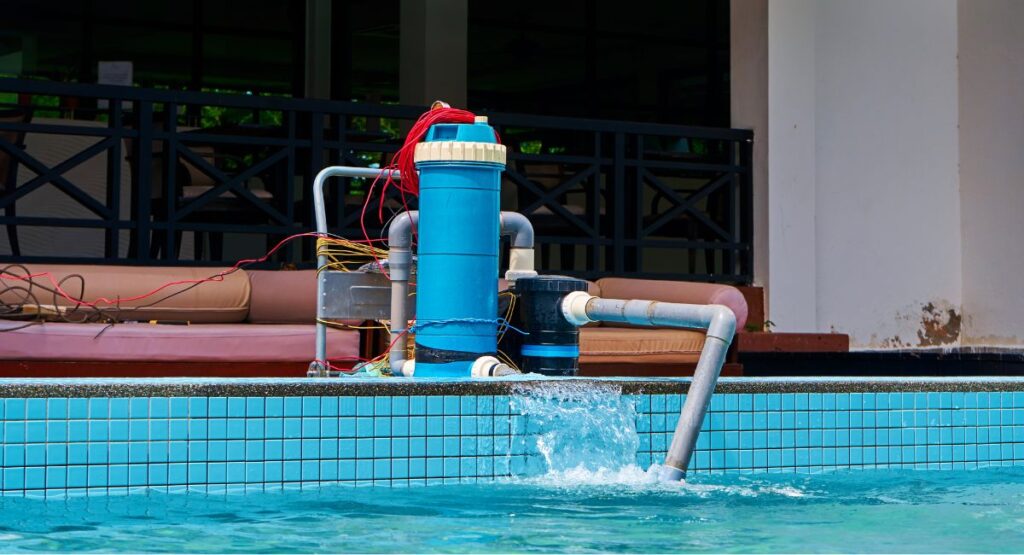
The pump is the heart of your pool’s circulation system, playing an indispensable role in keeping the water clean and clear. From my extensive experience in the industry, I can vouch for the significance of running the pump daily to ensure the water remains in top condition.
Optimal Daily Running Time for the Pump
A common question pool owners ask is, “How long should I run my pool pump each day?” While the answer can vary based on several factors, a general guideline is to run the pump for about 8 to 12 hours daily. This duration ensures that the water is adequately circulated, preventing stagnation and promoting effective filtration.
Factors Influencing Pump Running Time
Several factors can influence the optimal running time for your pump:
- Pool Size: Larger pools may require longer pump operation to ensure that all the water is circulated.
- Usage: After heavy pool use, it might be beneficial to run the pump longer to help filter out contaminants.
- Weather: On hotter days, especially in regions like Houston, running the pump longer can help combat algae growth due to higher temperatures.
9. Clean the skimmer and pump baskets weekly
The skimmer and pump baskets play a crucial role in your pool’s cleaning process. They catch larger debris, preventing them from reaching the pump or the filter. Regular cleaning of these baskets is essential to ensure the smooth operation of your pool’s circulation system and maintain water clarity.
The Need for Regular Cleaning
Weekly cleaning of skimmer and pump baskets is more than just routine maintenance—it’s an essential step for optimal water cleanliness. As these baskets collect debris, they can become clogged. A clogged basket not only reduces the efficiency of the skimmer and pump but can also put strain on the pump as it has to work harder to circulate water.
Steps to Clean the Baskets
- Turn Off the Pump: Before removing any baskets, always ensure the pump is turned off to ensure safety.
- Remove and Empty the Baskets: For the skimmer basket, open the skimmer lid, pull out the basket, and empty its contents. Similarly, for the pump basket, open the pump lid, remove the basket, and discard the debris.
- Rinse and Inspect: Use a garden hose to rinse off any remaining debris from the baskets. Inspect them for any signs of wear or damage. A damaged basket should be replaced promptly as it might not catch debris effectively.
- Reinstall the Baskets: Once cleaned and inspected, place the baskets back in their respective positions and secure the lids.
10. Winterize the pool
Winterizing is an essential process for those residing in areas where temperatures drop significantly during the winter months. Properly preparing your gunite pool for the colder season can prevent potential damage and ensure a smooth start-up when warmer weather returns.
Steps to Winterize the Pool
- Balance the Water Chemistry: About a week before closing your pool, adjust the pH, alkalinity, and calcium hardness levels. This ensures the water remains in good condition during the winter months and helps prevent scale build-up and corrosion.
- Clean the Pool Thoroughly: Before closing, ensure the pool is as clean as possible. Vacuum the pool, brush the walls and floor, and clean out all baskets.
- Lower the Water Level: Depending on your pool and cover type, you might need to lower the water level. Typically, it’s lowered below the skimmer and return jets for mesh covers.
- Drain the Equipment: Water left in the equipment can freeze and cause damage. Ensure you drain the pump, filter, heater, and any other equipment. Remember to open the air relief valve on the filter during this process.
- Add Winterizing Chemicals: These chemicals help keep the water clear of algae and bacteria during the off-season.
- Cover the Pool: Using a high-quality winter cover, such as the “Blue Wave Rectangular In Ground Pool Winter Cover,” ensures debris stays out, and the pool remains clean. These covers are designed to withstand the elements, providing reliable protection.
For a more detailed guide, you can refer to our how to winterize a gunite pool article.
Preventing Winter Issues
Winterizing properly is all about prevention. By taking the steps mentioned, you’re preventing potential issues like frozen pipes, algae growth, and equipment damage. It’s worth noting that even during the winter, it’s good to periodically check on your pool, ensuring the cover is secure and no issues are developing.
11. Maintain the pool area
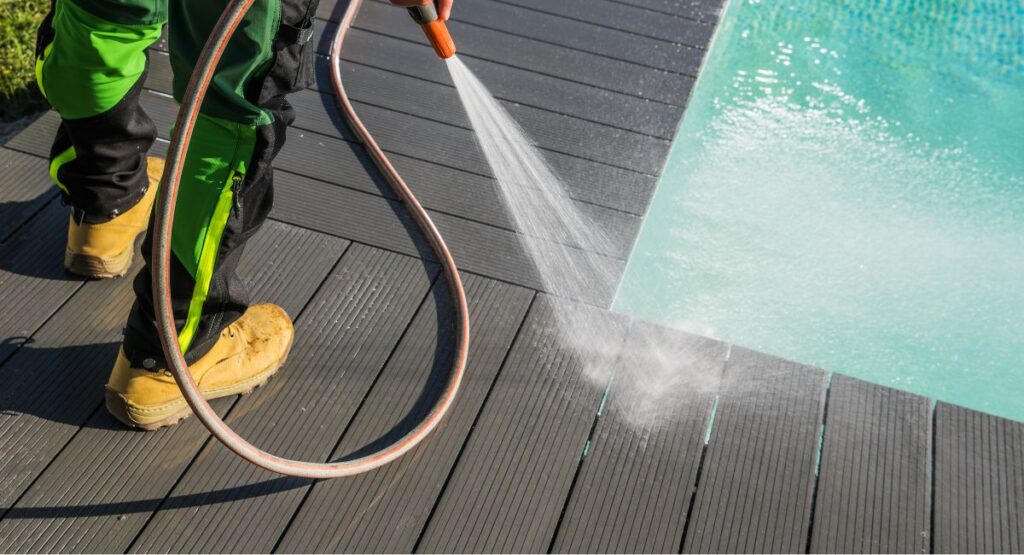
Beyond the shimmering waters of your gunite pool lies the pool area—comprising the deck, tiles, and surrounding spaces. Just as the pool water requires regular maintenance, so does this area. Keeping it clean and sanitized not only enhances the pool’s overall appeal but also ensures a safe environment for everyone.
Clean and Disinfect the Deck and Tiles
The pool deck and tiles can accumulate dirt, grime, and even algae over time. Regular cleaning ensures these surfaces remain slip-resistant and aesthetically pleasing.
- Scrubbing: Begin by scrubbing the surfaces to dislodge dirt and algae.
- Disinfecting: Post scrubbing, it’s essential to disinfect the area to eliminate germs and bacteria.
Prevention of Germ and Bacteria Transfer
While regular cleaning is essential, prevention is equally crucial. Here are a few tips to minimize germ and bacteria transfer:
- Foot Baths: Placing a foot bath at the pool’s entrance can significantly reduce the introduction of contaminants. Encourage swimmers to rinse their feet before entering the pool area.
- Regular Rinsing: Encouraging swimmers to take a quick shower before diving in can reduce the introduction of contaminants, lotions, and oils.
- Anti-Bacterial Mats: Consider placing anti-bacterial mats at the pool’s entrance. They are designed to minimize the transfer of bacteria and other microorganisms into the pool area.
How Much Does It Cost to Maintain a Gunite Pool
The cost of maintaining a gunite pool can vary depending on factors such as pool size, location, local labor rates, and the level of maintenance required. On average, you can expect to spend around $1,200 to $2,500 annually for routine maintenance of a gunite pool. This includes expenses for water chemistry testing, chemicals (such as chlorine, algaecide, and pH adjusters), electricity for the pool pump, occasional filter replacements, and general cleaning supplies.
Additionally, you may need to budget for more significant expenses that can arise over time, such as pool resurfacing (approximately $8,000 to $15,000 every 10-15 years), pump or equipment repairs, and potential plumbing issues.
For a more detailed breakdown of the costs associated with maintaining a gunite pool and valuable tips on pool care, you can refer to our Gunite Pool Maintenance Cost blog.
Conclusion
Maintaining a gunite pool is essential for preserving its beauty, functionality, and longevity. By following the guidelines and tips outlined in this article, pool owners can ensure that their investment remains in pristine condition for years to come.
Regular cleaning, balanced water chemistry, and diligent inspection of the pool’s structural integrity are key factors in preventing damage and costly repairs. Additionally, adopting good practices for pool usage and implementing preventative measures can enhance safety and enjoyment for all pool users.
Remember, consistent maintenance not only enhances the overall aesthetics and performance of the pool but also contributes to a safe and healthy environment. By taking the time to care for your gunite pool properly, you can relish in the joys of a beautiful, refreshing oasis for countless seasons of poolside fun and relaxation.
Frequently Asked Questions
1. Can I use automatic pool cleaners in my gunite pool?
Yes, most automatic pool cleaners are compatible with gunite pools and can efficiently clean the pool’s surfaces, including walls, floor, and steps. There are different types of automatic pool cleaners available, such as robotic cleaners, suction-side cleaners, and pressure-side cleaners. When choosing an automatic cleaner for your gunite pool, ensure that it is suitable for your pool’s shape and size, and follow the manufacturer’s guidelines for proper usage and maintenance.
2. Is professional maintenance necessary for a gunite pool?
While regular DIY maintenance is essential for day-to-day care, enlisting the services of a pool professional is beneficial for occasional inspections, repairs, and handling more complex issues. Pool professionals have the expertise and equipment to conduct thorough inspections, identify potential problems early on, and offer appropriate solutions. Regular professional check-ups can help prolong your pool’s lifespan, ensure optimal performance, and save you money on costly repairs in the long run. Additionally, a pool professional can provide valuable advice on pool care, maintenance best practices, and proper chemical balancing.
3. Are gunite pools hard to maintain?
Gunite pools are not inherently hard to maintain, but they do require consistent and proper care. Due to their porous nature, they can be susceptible to algae growth if not cleaned regularly. With a routine maintenance schedule that includes regular cleaning, chemical balancing, and equipment checks, gunite pools can remain in excellent condition for years.
4. What is the life expectancy of a gunite pool?
With proper maintenance, a gunite pool can last 20 years or more. However, the pool’s interior finish may need to be resurfaced every 7 to 15 years, depending on the type of finish and the level of care. The pool’s structure, made of gunite, is highly durable and can last for decades.
5. How often should a gunite pool be brushed?
A gunite pool should be brushed at least once a week to prevent algae growth and remove any debris that may settle on its porous surface. For new gunite pools, it’s recommended to brush the pool twice daily for the first few weeks to remove plaster dust. Regular brushing helps in maintaining the pool’s appearance and health.
